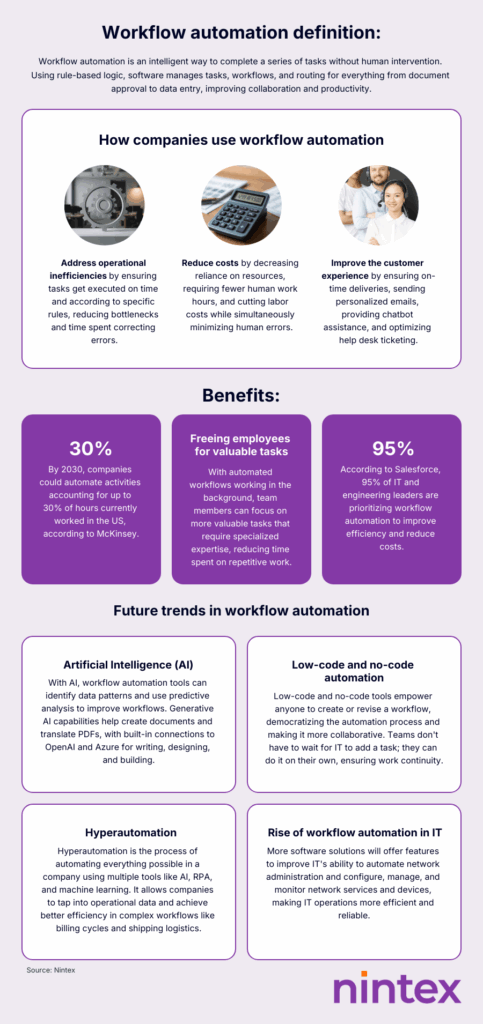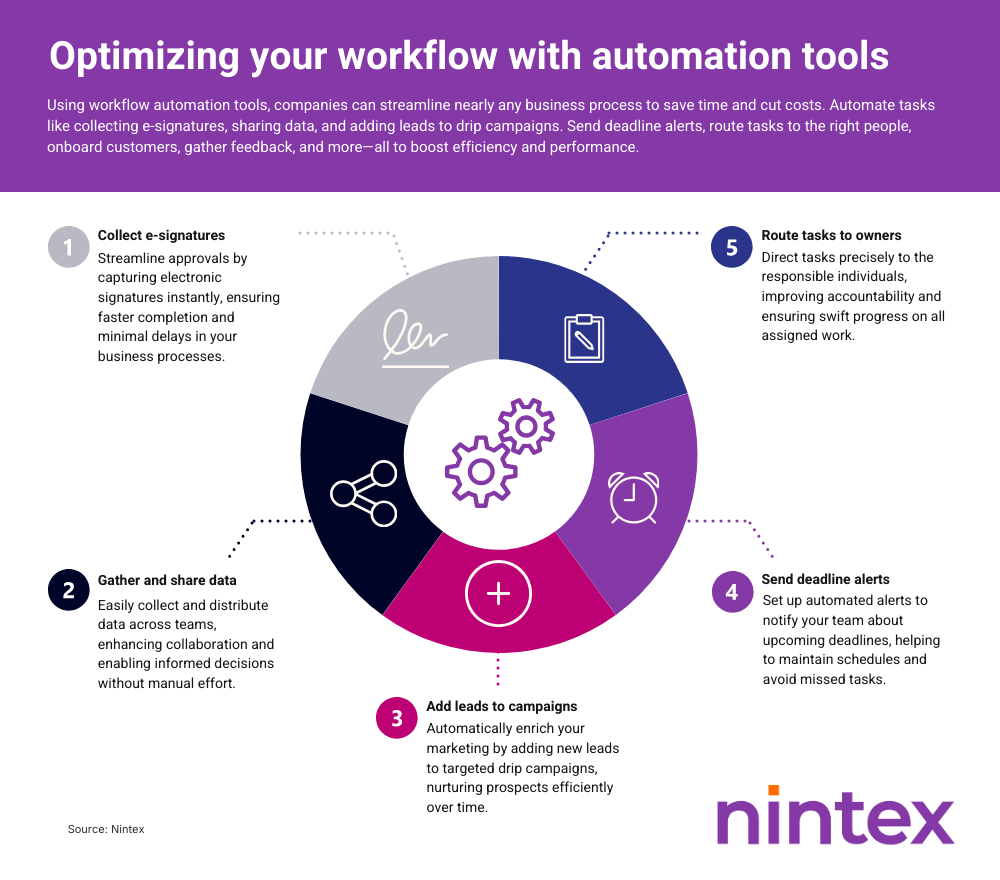Sometimes it makes good business sense for humans to stay out of the way. Workflow automation is an intelligent way to complete a series of tasks without the need for human intervention. Using rule-based logic, software manages tasks, workflows, and routing for everything from document approval to data entry.
Explore how workflow automation improves collaboration and productivity and how to find and implement the right software.

Definition of workflow automation (and how companies use it)
Workflow automation is the act of replacing manual workflows with automated rules and triggers. For example, once someone completes one task in a series, the automation will launch the next task.
Companies use automated workflows to:
- Address operational inefficiencies: Automation ensures that tasks get executed on time and according to specific rules. This reduces bottlenecks and the time spent correcting errors.
- Free up employees’ time for valuable tasks: With automated workflows working in the background, team members can focus on more valuable tasks that require specialized expertise.
- Reduce costs: With workflow automation, businesses reduce their reliance on resources. They need fewer human work hours, cutting labor costs.
- Minimize mistakes: Less reliance on human employees means fewer opportunities for human error—and less time spent fixing those mistakes.
- Improve the customer experience: Automated workflows reduce bottlenecks and errors to ensure more on-time deliveries. Businesses also use them to send personalized emails, provide chatbot and live chat assistance, and optimize help desk ticketing.
- Facilitate collaboration between team members: Companies use workflow automation to send timely notifications, improve visibility into operations, and offer real-time project updates. By keeping everyone in the loop, workflow automation improves teamwork and communication.
Workflow automation in action
Using workflow automation tools, companies can streamline nearly any business workflow to save time and money. For example, you can:
- Collect e-signatures in your approval process
- Gather and share dataAdd leads to drip campaigns
- Send alerts for approaching deadlines
- Route tasks to the person responsible
- Onboard customersGather post-purchase feedback
- Generate and send invoicesApprove leave requests
- Manage support tickets
- Create reports
Workflow automation software integrates with other tools, so you can easily manage complex and related workflows. For example, you might set up a single workflow that creates a record in your customer relationship management (CRM) software, populates a list in a database, and alerts select employees in your company’s messaging app.
Apparel maker Lands’ End created a Nintex workflow to speed up custom orders for logoed apparel, which was previously a slow, manual, paperwork-heavy process. Since implementation, they’ve seen a 76% reduction in workflow steps and order accuracy has risen from a mere 50% to 95%. This means Lands’ End deals with less rework and saves money, all because of workflow automation.
How to choose the right workflow automation software
Not all workflow automation tools are created equal. When selecting a platform, consider factors like your company’s budget, number of employees, and inefficiencies. Then, select software that most closely meets your criteria.
Some key features and functionalities to look for include:
| Low-code design An intuitive user interface reduces the software’s learning curve and reliance on IT— and increases your time to value. Look for an option that lets employees drag and drop visual elements onto a workflow design canvas without any coding knowledge. | Customization Your company has workflow automation needs unique to your business model, employees, and existing technology. Choose software that lets you customize your workflows with conditional logic, integrations, and form styling. |
| Reports and analytics Most automation platforms let you monitor and improve workflow performance on a dashboard. Make sure you choose a solution that also offers built-in reporting, so you can download insights reports to discuss with your team. | Cloud operability Cloud-based tools give you access to your workflows from anywhere. This is essential for companies with remote team members, but it has other advantages, too. There’s typically less maintenance and more data security and privacy. |
| Templates You’ll likely need your workflow to generate documents and forms. Starting with a template allows you to save time while still achieving a customized result. Consider software with AI-enhanced capabilities to build and translate your forms and options like geolocation tags and attachments. | Integrations Workflow automation software needs to integrate into your existing tech stack. Check the vendor’s integrations page to make sure it offers built-in connections to popular apps and Open API options to provide more options. |
| Customer support Support varies widely among workflow automation products and specific pricing tiers. You might need help with basic installation or more in-depth assistance with configuration and usage. Choose software that offers the support you need, the way you need it—whether that’s with a self-serve knowledge base or over-the-phone guidance. | Pricing Seek out a product with flexible pricing tiers so you aren’t paying for more features than you need. Some companies that offer workflow automation tools create custom pricing packages upon request. |
Steps to implement workflow automation

Workflow automation streamlines and optimizes business tasks, saving time, reducing errors, and improving your company’s overall efficiency. Here’s how to get started with workflow automation in six steps:
Step 1: Identify a workflow to automate
The first step in implementing workflow automation is to identify tasks or operations that might benefit from automation. Try not to rely on guesswork or hunches. Instead, map your current operations, and analyze where you can improve them. Look for repetitive tasks, manual approvals, or any areas where bottlenecks occur. Then, interview or survey employees about their biggest roadblocks and frustrations.
Step 2: Define your goals
The data you collect in step one should help you articulate your desired goals. What do you hope to get out of eliminating this workflow’s inefficiencies? For example, you may want to achieve faster time-to-market, increased productivity, or a higher return on investment (ROI). Make sure your objective is measurable and that it supports at least one organizational goal to improve buy-in.
Step 3: Choose the right tool
If you don’t yet have a workflow automation tool, choose one that aligns with your company’s needs. Look for a user-friendly, scalable solution that offers robust features like drag-and-drop functionality, integration capabilities, and reporting. Many companies offer a live demo or free trial to ensure the software works for you before you invest in it.
Step 4: Design and build the new workflow
In your automation tool, map out the new workflow on a canvas. First, identify and configure the start event — the beginning of your workflow. For example, your workflow might start when someone creates a file in Google Drive or fills out a form. Then, add and configure additional actions and dependencies on your map. This sounds complicated, but you can do it easily through a drag-and-drop interface with the right software.
Step 5: Test and refine the workflow
Before deploying the workflow automation, test it to ensure it functions as intended. Many workflow management platforms let you run a sample workflow before you hit publish. Then, continue to iterate until you achieve the desired outcome.
Workflow automation vs. robotic process automation
Workflow automation and robotic process automation (RPA) both help an organization streamline workflows and improve efficiency by reducing employees’ workload.
Workflow automation defines and optimizes an end-to-end process to run independently without human intervention. You might use it to map your expense approval process from start to finish—creating a workflow that automatically generates forms, automates tasks, sends status updates, and collects signatures. With low-code workflow automation software, it’s easy to drag and drop components onto a visual interface.
Robotic process automation provides organizations with a team of virtual software ‘robots’ to complete repetitive tasks for human employees. These bots can do time-consuming tasks like monitoring inventory, training employees, or populating spreadsheets. For example, instead of manually transferring data from one application to another, RPA can do it for you. This eliminates possible errors and saves you from a tiresome task — giving you more time for creative or strategic responsibilities.
And organizations don’t have to choose between workflow automation and robotic process automation. Most find the two solutions complement each other to improve their operational efficiency, allow for business agility, and improve employee satisfaction.
Future trends in workflow automation
Workflow automation is changing the way people do business. By 2030, companies could automate activities accounting for up to 30% of hours currently worked in the US, according to McKinsey.
With more organizations leaning on automation, it’s worth taking a closer look at four rising trends:
- Artificial intelligence (AI)
With the help of AI, workflow automation tools can identify data patterns and use predictive analysis to improve workflows. Generative AI capabilities help you create documents and translate PDFs from one language to another. As time goes on, more solutions will offer built-in connections to OpenAI and Azure to offer easy options for writing, designing, and building. - Low-code and no-code automation
Companies want workflow technology that allows for quick adoption and scaling. Low-code and no-code tools make that possible. They empower anyone to create or revise a workflow, democratizing the automation process and making it more collaborative. Teams don’t have to wait for IT to add a task; they can do it on their own, ensuring work continuity. - Hyperautomation
Hyperautomation is the process of automating everything possible in a company. Organizations that lean into hyperautomation adopt multiple tools to streamline repetitive or mundane tasks, such as AI, RPA, and machine learning (ML). Named by Gartner as a top strategic technology trend in 2022, hyperautomation continues to soar. It allows companies to tap into their operational data and achieve better efficiency and accuracy in complex workflows like billing cycles, shipping logistics, customer service communications, and business analytics. - The rise of workflow automation in IT
According to Salesforce, 95% of IT and engineering leaders are prioritizing workflow automation. More software solutions will offer features to improve IT’s ability to automate network administration and configure, manage, and monitor network services and devices.
Contact us to learn more about how automation can help your business.
Problems & Solutions
| Common challenges | Solutions |
|---|---|
| Time-consuming repetitive tasks | Automate repetitive tasks to streamline operations |
| High error rates in manual processes | Implement automated workflows to enhance accuracy |
| Decision-making bottlenecks | Use automation to speed up decision-making |
| Fragmented data across systems | Integrate systems for seamless data flow |
| Resistance to new technology | Offer training to ease the transition to new technology |
FAQ
Q. What is workflow automation?
A. It’s the use of technology to automate and streamline repetitive tasks and business processes, boosting efficiency and reducing errors.
Q. How does workflow automation benefit a business?
A. Workflow automation improves productivity, reduces human error, and optimizes resources, resulting in cost savings and enhanced operational efficiency.
Q. What are some examples of workflow automation?
A. Examples include automated patient intake forms in healthcare and automated approval workflows in finance.
Q. What should I look for in workflow automation software?
A. Key features include a user-friendly interface, integration capabilities, and scalability to adapt to your organization’s growth.
Explore these other topics:
- What is a workflow?
- What is application development?
- What is citizen development?
- What Is intelligent automation?
- What is low code?
- What Is low-code automation?
- What is mobile workflow management?
- What is no-code vs low-code automation?
- What is process analytics?
- What is process automation?
- What is process improvement?
- What is process integration?
- What is process optimization?
